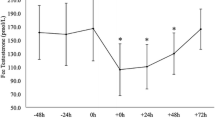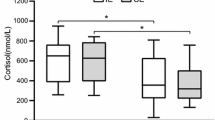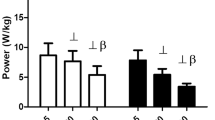Abstract
Free testosterone (FT) hormonal responses were compared between high-intensity interval exercise (IE) and steady-state endurance exercise (SSE) in endurance trained males (no.=15). IE session was repeated periods of 90-sec treadmill running at 100–110% maximal oxygen uptake (VO2max) and 90-sec active recovery at 40% VO2max for 42–47 min. The SSE session consisted of a continuous 45-min run at 60–65% VO2max. Total work output was equal for each exercise session. A 45-min supine rest control session (CON) was also performed. All three sessions were on separate days. Pre-session (PRE), immediate post-session (POST), and 12-h post-session (12POST) blood samples were collected and used to determine FT, SHBG, LH, 3-α-androstanediol glucuronide (3-α Diol G) and cortisol. Analysis of variance compared IE and SSE biomarker responses to the reference CON session. IE and SSE each caused an increase (p<0.01) in FT, but IE more so than SSE (p<0.05). The 5α-reduc-tase marker 3-α Diol G response at 12POST IE was elevated while FT was reduced (p<0.05); no such change occurred following SSE. These findings suggest IE might produce a more pronounced turnover of FT by androgen sensitive tissue than the SSE form of exercise.
Similar content being viewed by others
References
McMurray RG, Hackney AC. The endocrine system and exercise. In: Exercise & Sports Science. Garrett W & Kirkendall D (eds). Philadelphia: Williams & Wilkins Publisher. 2000, 135–62.
Brooks GA, Fahey TD, White TP. Neural-endocrine control of metabolism. In: Exercise Physiology: Human Bioenergetics and its Application, 2nd edition. Toronto: Mayfield Publishing. 1996, 156–96.
Viru A, Viru M. Biochemical Monitoring of Sport Training. Champaign IL: Human Kinetics Publishing. 2001, 91–142.
Joyner MJ, Coyle EF. Endurance exercise performance: the physiology of champions. J Physiol 2008, 586: 35–44.
Laursen PB, Jenkins DG. The scientific basis of high intensity interval training. Sports Med 2002, 32: 53–73.
Hackney AC, Viru A. Research methodology: endocrinologic measurements in exercise science and sport medicine. J Athletic Training 2008, 43: 631–9.
ACSM’s Guidelines for Exercise Testing and Prescription, 8th edition. Baltimore, Maryland: Lippincott, Williams & Wilkins. 2009, 97–154.
Hackney AC, Kallman A, Hosick KP, Rubin DA, Battaglini CL. Thyroid hormonal responses to intensive interval versus steady-state endurance exercise sessions. Hormones (Athens) 2012, 11: 54–7.
ACSM’s Metabolic Calculations and Handbook. Baltimore, Maryland: Lippincott, Williams & Wilkins. 2007, 35–40.
Tietz NW. Clinical Guide to Laboratory Tests. Philadelphia: Saunders Publishing. 1990, 78–130.
Levene H. Robust tests for equality of variances. In: Contributions to Probability and Statistics. Olkin I (ed), Palo Alto, CA: Stanford Univ. Press. 1960, 278–92.
Derbré F, Vincent S, Maitel B, et al. Androgen responses to sprint exercise in young men. Int J Sports Med 2010, 31: 291–7.
Zouhal H, Jacob C, Delamarche P, Gratas-Delamarche A. Catecholamines and the effects of exercise, training and gender. Sports Med 2008, 38: 401–23.
Ross RK, L Bernstein, RA Lobo, et al. 5-alpha-reductase activity and risk of prostate cancer among Japanese and US white and black males. Lancet 1992, 339: 887–9.
Author information
Authors and Affiliations
Corresponding author
Rights and permissions
About this article
Cite this article
Hackney, A.C., Hosick, K.P., Myer, A. et al. Testosterone responses to intensive interval versus steady-state endurance exercise. J Endocrinol Invest 35, 947–950 (2012). https://doi.org/10.1007/BF03346740
Accepted:
Published:
Issue Date:
DOI: https://doi.org/10.1007/BF03346740




